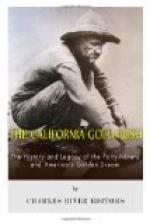At the end of that period, however, things began to suffer a change. The time of pioneering came to an end, and the new age of material prosperity began. Evils of various sorts crept in. The pioneer priests were in some instances replaced by men who thought more of the flesh-pot than of the altar, and whose treatment of the Indians left very much to be desired. Squabbles arose between the civil and the religious powers. Envy of the missions’ immense holdings undoubtedly had its influence. The final result of the struggle could not be avoided, and in the end the complete secularization of the missions took place, and with this inevitable change the real influence of these religious outposts came to an end.
Thus before the advent in California of the American as an American, and not as a traveler or a naturalized citizen, the mission had disappeared from the land, and the land was inhabited by a race calling itself the gente de razon, in presumed contradistinction to human beasts with no reasoning powers. Of this period the lay reader finds such conflicting accounts that he either is bewildered or else boldly indulges his prejudices. According to one school of writers—mainly those of modern fiction—California before the advent of the gringo was a sort of Arcadian paradise, populated by a people who were polite, generous, pleasure-loving, high-minded, chivalrous, aristocratic, and above all things romantic. Only with the coming of the loosely sordid, commercial, and despicable American did this Arcadia fade to the strains of dying and pathetic music. According to another school of writers—mainly authors of personal reminiscences at a time when growing antagonism was accentuating the difference in ideals—the “greaser” was a dirty, idle, shiftless, treacherous, tawdry vagabond, dwelling in a disgracefully primitive house, and backward in every aspect of civilization.
The truth, of course, lies somewhere between the two extremes, but its exact location is difficult though not impossible to determine. The influence of environment is sometimes strong, but human nature does not differ much from age to age. Racial characteristics remain approximately the same. The Californians were of several distinct classes. The upper class, which consisted of a very few families, generally included those who had held office, and whose pride led them to intermarry. Pure blood was exceedingly rare. Of even the best the majority had Indian blood; but the slightest mixture of Spanish was a sufficient claim to gentility. Outside of these “first families,” the bulk of the population came from three sources: the original military adjuncts to the missions, those brought in as settlers, and convicts imported to support one side or another in the innumerable political squabbles. These diverse elements shared one sentiment only—an aversion to work. The feeling had grown up that in order to maintain the prestige of the soldier in the eyes of the natives it was highly improper that he should ever do any labor. The settlers, of whom there were few, had themselves been induced to immigrate by rather extravagant promises of an easy life. The convicts were only what was to be expected.




